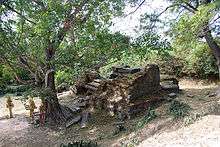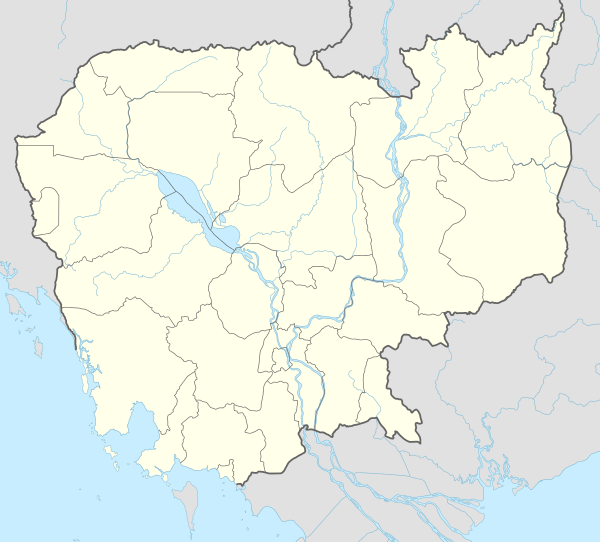Ak Yum
Ak Yum (Khmer: ប្រាសាទអកយំ) is an ancient temple in the Angkor region of Cambodia.[2]:350,352 Helen Jessup dates the temple to the 8th century, and states it is the oldest known example of "temple mountain" in Southeast Asia.[3][4]
| Ak Yum | |
|---|---|
 Ruin of the temple | |
| Religion | |
| Affiliation | Hinduism |
| Province | Siem Reap |
| Deity | Gambhiresvara |
| Location | |
| Location | Angkor |
| Country | Cambodia |
 Location within Cambodia | |
| Geographic coordinates | 13°25′28″N 103°46′36″E |
| Architecture | |
| Type | Khmer (Kompong Preah style[1]) |
| Completed | 2nd half of the 8th century AD |
The origins and repair history of the temple are unclear. Stone carrying inscriptions, including one with a date corresponding to Saturday 10 June 674 AD during the reign of king Jayavarman I. The first structure on the site was a single-chamber brick sanctuary, probably constructed in the latter part of the 8th century. Later it was remade into a larger stepped pyramid structure, with a base approximately 100 meters square. The expansion probably took place in the early 9th Century during the reign of King Jayavarman II, who is widely recognized as the founder of the Khmer Empire. When the West Baray reservoir was built in the 11th Century, Ak Yum was partially buried by the southern dike. The site was excavated in the 1932 under the direction of archaeologist George Trouvé.
Gallery
 Prasat Ak Yum
Prasat Ak Yum The wall of the temple
The wall of the temple
References
- Ancient Angkor guide book, by Michael Freeman and Claude Jacques, p.30, published in 2003
- Higham, C., 2014, Early Mainland Southeast Asia, Bangkok: River Books Co., Ltd., ISBN 9786167339443
- Helen I Jessup (2004), Art & Architecture of Cambodia, London: Thames & Hudson, ISBN 978-0500203750, pages 60-61
- Michael W. Meister (2006), Mountain Temples and Temple-Mountains: Masrur, Journal of the Society of Architectural Historians, Vol. 65, No. 1 (Mar., 2006), University of California Press, pp. 39- 44;
- Higham, Charles. The Civilization of Angkor. University of California Press 2001. p. 96
